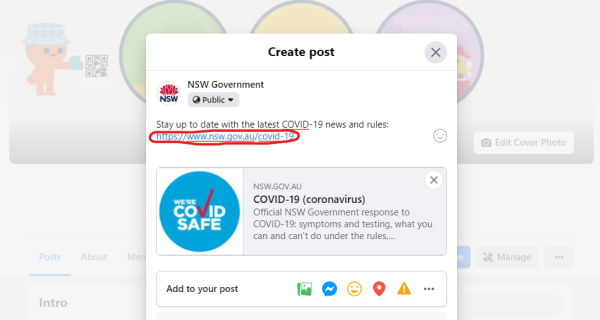Accessibility and inclusion on social media
Ensure information on social media is accessible and inclusive of all users regardless of their ability and environment.
Everyone should have equal access to information.
Under the Disability Discrimination Act 1992 and Anti-Discrimination Act 1977, the NSW Government is required to provide information and services in a way that is accessible and doesn’t discriminate.
Web Content Accessibility Guidelines
NSW Government digital products and services need to meet the current version of the Web Content Accessibility Guidelines (WCAG) to level AA for Government websites, web content and apps. Unlike websites, we don't have control over the accessibility features provided by external social media platforms.
Accessibility is essential for all
Accessibility is about more than just ticking a box. It ensures everyone, including people from marginalised groups, can access information with ease. This includes:
- people with disability
First Nations Australians
- rural and remote Australians
- low-income households and those with mobile-only data connection
- people who don’t speak English as a first language
- older Australians
- people with low levels of education.
It is important you do everything you can to make the content you publish, including images, videos, text and links, accessible.
Accessibility features often benefit others (this is known as the 'curb-cut effect'). For example, video captions for people who are deaf or hard of hearing also benefit people watching without headphones.
Make visuals accessible
Crucial information contained in images, videos and GIFs should be accessible to all people.
Some rules apply to all visuals:
- have a text alternative to convey meaning for any important non-text elements (it doesn’t have to be verbatim but should convey the same meaning)
- never use colour alone to convey meaning (including in diagrams and charts)
- avoid flashing or strobing that might induce seizures due to photosensitivity (for example, in people with epilepsy)
- use strong colour contrast between background and foreground colours (that is, a minimum contrast ratio of 4.5:1 and goal of 7:1).
Alt text
To ensure that your images are available to everyone, you should add alternative text (often called alt text) where possible.
Limitations of alt text on social media
At the time of writing, alt text cannot be added to GIFs on some platforms (including Facebook). Where alt text can’t be included, you must make sure any important information conveyed via an image or GIF is also conveyed in the post copy.
Even though most platforms now have alt text capabilities, you may need to turn it on in your account settings.
Few scheduling tools allow you to add alt text, so where possible add alt text after the post is live or include alt text when scheduling or posting natively.
How to write alt text for social media
When writing alt text:
- use short, simple sentences
- keep explanations short and objective
- write as though you are speaking, verbal explanations often have the right tone
- ensure that a person who can't access the visual has access to the same information as any other viewer.
Example:

[Image description: Tan sausage dog rests on beige carpet looking straight ahead, a plate stacked with two doughnuts sits to his left.]
Image galleries
For image galleries, add text alternative using the alt text field (if it exists) or in the space provided for captions (if possible).
Avoid images of excessive text
Avoid posting images or videos of excessive text including:
- screenshots of information to get around character limits
- PDFs, flyers or similar content not designed for social media.
Logos, maps, diagrams, graphs, charts and infographics
If you need to post images with text in them:
- use large text
- use plain, readable fonts
- ensure a minimum colour contrast of 4:5:1 between font and background colour.
If alt text isn't available
If alt text isn’t available on the social media platform you are using, describe the image in the copy if it conveys important information.
Videos
Where possible, videos shared on social media should have:
- a clear title
- a description
- captions and/or a transcript to ensure dialogue and sounds are accessible.
Always review auto-generated captions suggested by platforms and update if necessary to be sure they're correct.
For stories and other disappearing content, add a text summary if you can’t add captions.
Live videos
Captions
Where possible, live videos on social media should offer high quality captions. Avoid automatically-generated captions unless necessary. Edit automatically-generated and live captions after the event if a video is used to provide information to the public afterwards.
Auslan interpreters
When producing videos for emergency communication, such as bushfires or floods, an Auslan interpreter must be present on screen for the entire duration of the video. For other videos, where possible, we recommend including an Auslan interpreter.
Position Auslan interpreters in a separate ‘bubble’. Remember that the interpretation will be a few seconds ‘behind’ the speaker, so the camera must stay on the interpreter until the interpretation is complete.
Don't cover up the Auslan interpreter with captions or other on-screen text.
Learn more about best practices for creating videos.
Links
How you use links in your posts and where those links lead may impact the user experience.
Avoid linking to content that is inaccessible to some customers or that discriminates in the level of accessibility provided. If you have to link to a PDF, ensure it is tagged, and warn users about the file type and size. For example, ‘[PDF, 1.6MB]’.
Clearly label or describe linked content. Some platforms allow you to edit information in a link preview, which can help to make information clearer.
If you’re using a link preview, delete the URL from your caption. For people using screen readers, including the link in text creates duplication and the URL may not be easy to read/listen to.

If you choose not to use a link preview, shorten the URL. People who use screen readers find it easier to listen to short URLs.
Shortened URLs such as bit.ly links should include customised back-halves using short and relevant keywords. If multiple words are used in the back-half, ensure ‘camel case’ or hyphens are used to separate words. For example, bit.ly/SocialMedia or bit.ly/social-media.
Post copy
The copy in your post should:
- be in plain English
- be readable (aim for a reading age of 9)
- use title case (also known as 'camel case') for hashtags — capitalise the first letter of every word so that screen readers can distinguish individual words (for example, #WriteLikeThis #notlikethis)
- include hashtags and @mentions at the end of your post (where possible) so the main part of the post can be read without interruption
- also consider the pronouns on the person you're addressing. They might prefer gender neutral language, which you can learn more about through the Australian Government's guidance on gender and sexual diversity.
The copy in your posts should avoid:
- acronyms and excessive or unnecessary abbreviations
- text-based emoticons like ':-)' which may be read by assistive technology as 'colon, dash, close-bracket'
- copying and pasting in fonts that are different to the standard platform font (for example, listen to a screen reader reading alternative fonts)
- use of foreign language words and phrases, except for proper names, technical terms or words that have become part of English
- use of multiple emojis in a row or between each word (for example, 👏 may be read as 'icon clapping hands emoji').
Contact details
The 'About' section of the social media profile page should include multiple options for getting in touch, for example email and phone details.
If possible, this should include contact information for accessibility support such as:
Tools and services to help with accessibility
If you need further help with:
- plain language, check the reading age using Hemingway
- contrast, use a colour contrast checker
- captions and transcripts, use free tools like Descript or transcription services like Rev (output should be reviewed for accuracy)
- image descriptions, use the decision tree to know when to include alt text
- understanding the screen reader experience, try a free screen reader like NVDA
- shortening links, try short.io or rebrandly which allow you to customise the URL to look like your website
- captions for live videos, consider engaging an agency like AI Media or Telestream
- Auslan-English interpretation and translation, consider engaging an agency like The Deaf Society or Sweeney Interpreting (which are based in NSW).
- accessibility and inclusivity, use the detailed instructions that Digital.NSW has to offer on alt text, video and audio, graphics and images, and writing.
Always read the terms of service and privacy policy before using any third-party tools and services to evaluate their security and content policies. Avoid sharing sensitive information with third parties if your data will not be secure.
Please note that any collection, storage, use and disclosure of information must comply with the Privacy and Personal Information Protection Act 1998 and the Health Records and Information Privacy Act 2002. Personal and health information should not be inputted or disclosed to public platforms and sites.
Accessibility guidance from the platforms
Social media platforms are at varying levels of maturity in their accessibility journey, so there are different amounts of guidance from them.